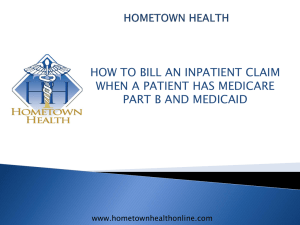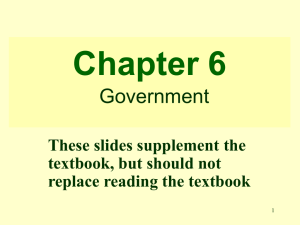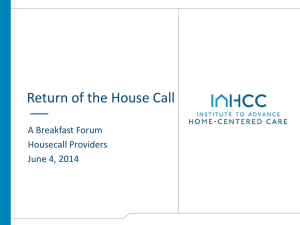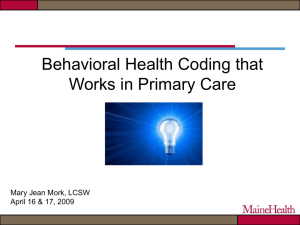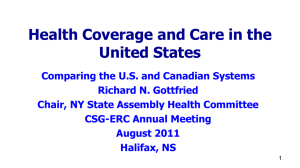Tips & Tricks for Effectively Communicating What`s in
advertisement
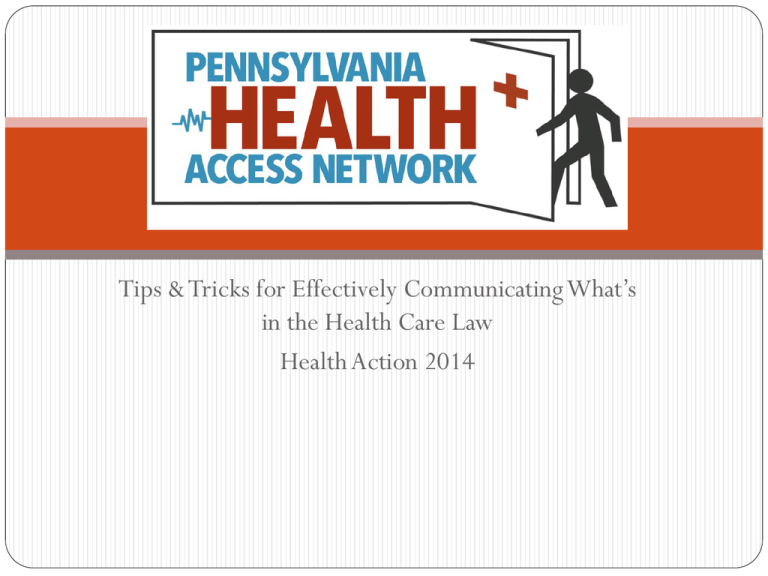
Tips & Tricks for Effectively Communicating What’s in the Health Care Law Health Action 2014 The U.S. Census Bureau reported that 49.9 million residents, 16.3% of the population, were uninsured in 2010 (up from 49.0 million residents, 16.1% of the population, in 2009). Thanks to Chris Lilienthal at Pennsylvania Budget and Policy Center This is about what reform would mean for the mother with breast cancer whose insurance company will finally have to pay for her chemotherapy. … This is about what reform would mean for middle-class families who will be able to afford health insurance for the very first time in their lives … and have some security about their children if they get sick Thanks to Chris Lilienthal at Pennsylvania Budget and Policy Center Making Connections Persuasive communications speaks to our deeply held values and beliefs as Americans. Thanks to Chris Lilienthal at Pennsylvania Budget and Policy Center Rules of Good Communications Thanks to Chris Lilienthal at Pennsylvania Budget and Policy Center Rules of Good Communications Thanks to Chris Lilienthal at Pennsylvania Budget and Policy Center Rules of Good Communication Thanks to Chris Lilienthal at Pennsylvania Budget and Policy Center In every presentation Cover: Insurance Reforms, Medicare & Medicare Advantage, the Marketplace, and Medicaid Expansion Expand if appropriate and if you’re comfortable Keep facts to a minimum Leave LOTS of times for questions Don’t worry about being an ‘expert’ Build trust with your audience The Affordable Care Act in Pennsylvania Tips and Tricks National data is helpful, but trust your field experiences You can be YOU - even with a topic like this Opposition interruptions are rare, but great opportunity to respond to room Intro slide to build trust, show off that you’re non-partisan Background terms: explain co-pay, co-insurance, deductible, premiums. (In our long version we have a slide for that). Take a step back to look at life before reform Explain reform doesn’t just expand access – introduce topics you’re covering About us.. Pennsylvania Health Access Network (PHAN) is a broad, non-partisan coalition that works to ensure all Pennsylvanians have access to quality, affordable health coverage. Represent approximately 60 organizations and a million consumers across the state. Recognized by media, lawmakers (R and D), state and federal officials, and consumer advocacy organizations as a credible source of information. Work to monitor implementation and push for reforms to be as consumer friendly as possible. Also known as Obamacare, the Health Care Law, ACA, Patient Protection and Affordable Care Act, PPACA Signed into law on March 23rd, 2010 Upheld by the Supreme Court as The Affordable Care Act Constitutional Subject of attacks and misinformation campaign launched by opponents still fighting for repeal Before health care reform.. For the decade leading up to reform, premiums were rising much faster than wages. Medical bills leading cause of family bankruptcy Rx drug costs were hurting seniors on fixed incomes Small businesses were paying 18% more than large companies for similar coverage People with pre-existing conditions had no protections Tips & Tricks: Insurance Reforms Always start with reforms Cover all reforms, even if you’re talking to seniors or only have 20 minutes Use stories or anecdotes to explain key provisions Save essential health benefits for marketplace Insurance Reforms Say goodbye to pre-existing conditions No more lifetime limits and annual limits Pulling coverage when you get sick now illegal Streamlined appeals process Children can stay on parent’s plan until 26 Insurance Reforms Continued ER access Direct access to OBGYN Medical Loss Ratio Justify rate hikes. Gender discrimination illegal. Age rating capped. Preventive care without co-pays Tips & Tricks Medicare Stress NO Guaranteed benefits cut Responding to the payment advisory board (“death panel”) questions Take your time to explain donut hole, but don’t worry about exact numbers Do NOT assume anyone gets the difference between Medicare and Medicare Advantage, even if you’re talking to a senior on Medicare Advantage Don’t skip 5 star rating system Responding to “billions” cut from Medicare Health Reform and Medicare No guaranteed benefits are cut. New Benefits for Seniors Free preventive care under Traditional Medicare Went into effect January 1, 2011 Includes colonoscopies, mammograms, annual wellness exam, annual flu shot, screenings for diabetes, and more Health Reform and Medicare Closing the donut hole 52.5% discount on brand name drugs and 28% on generic. In 2012, 222,703 Pennsylvanians saved over $168 million, an average of $753 per beneficiary. Extends life of Medicare Trust Fund by at least 8 years Cracking down on waste, fraud, and abuse Since 2009, $14.9 billion in fraudulent payments have been returned to Medicare Trust Fund Medicare Advantage Private insurance 1997 – Payouts roughly equal to cost of traditional Medicare 2003 – Congress votes to increase payouts 2009 – Medicare pays 14% more per beneficiary than traditional Medicare Medicare Advantage and ACA Every Medicare Advantage plan is rated on a 1 to 5 star system. Rating of 1 – 3 stars means: No more bonus payments Must increase rating in 3 years Rating of 4-5 star means: Bonus payments, but every dollar must to be used to benefit seniors Only for 5 star plans: Seniors can switch into 5 star plan anytime of year Check your rating and compare plans in your area at www.medicare.gov/find-a-plan or calling 1-800-MEDICARE Medicare Advantage and ACA Medical Loss Ratio It’s working In 2011: Medicare Advantage enrollment increased by 10% and premiums fell by an average of 7% Tips & Tricks for Marketplace Don’t take questions during this section, even for small, informal presentations Break it up: Basics, EHB, Plan types, Tax credits, How you get it Stress MOC involvement – use that as transition to QHP Forget about actuarial value, use low/high Show what FPL means in annual income and hourly wages Don’t talk about it as a website Health Insurance Marketplace Uninsured, small business owners, people paying more than 9.5% of pay on premiums & Members of Congress Qualified Health Plan Tax credits and cost-sharing subsidies Essential Health Benefits Package •Ambulatory patient services •Emergency services •Hospitalization •Maternity and newborn care •Mental health services •Prescription drugs •Habilitative &Rehabilitative services •Laboratory services •Preventive and wellness care •Pediatric services Level Monthly Premium CoPay or Outof-Pocket Costs Platinum Highest Lowest Gold High Low Silver Middle Middle Bronze Low High Catastrophic Plan Much lower premiums, but high deductibles Available to 30 and under or those who receive financial hardship exemptions Covers 3 primary care visits and free preventive care benefits After deductible is met, all essential health benefits are covered Premium Tax Credit Eligibility FPL 100% 400% Annual – 1 person Hourly Full/Part time – 1 person Annual – 4 persons household Hourly Full/Part time – 4 persons $11, 490 $45,960 $5.52/$11.04 $11.32/$22.64 $23,550 $94,200 $22.09/$44.19 How Tax Credits Work Paid directly to insurance company Marketplace lets you know how big of a credit you’re eligible for. Based on silver level plan, but you pick the plan you want. Tax credits based on projected income Help with out of pocket costs Folks at or below 250% of FPL ($28,725/yr individual; $58,875/yr family of 4) eligible for reduced cost sharing Must be getting Premium Tax Credit Have to be enrolled in a silver-level plan Caps on out of pocket expenses But HOW do I get it? Visit www.healthcare.gov Call 1-800-318-2596 • Customer service representatives - 24/7 • English and Spanish • Language line for 150 additional languages But HOW do I get it? (continued) Talk to a Navigator or a Certified Application Counselor Visit www.localhelp.healthcare.gov to find one near you! Can’t find one near you? Call PHAN. We have CAC’s that can help you: 1-877-570-3642 Special Enrollment Period Qualifying Events Loss of minimum essential coverage Material contract violations by Qualified Health Plans Gaining or becoming a dependent Gaining or losing eligibility for premium tax credits or cost-sharing reductions Gaining lawful presence Relocation resulting in new or different Qualified Health Plan selection Enrollment errors of the Marketplace Exceptional circumstances Tips & Tricks for Medicaid Explain how Medicaid works in your state pre-ACA first Most popular messaging point is security, second is uncompensated care savings Explain savings, but focus on people If you’re in a state that hasn’t expanded you’ll need to explain the gap at least twice during presentation. Text here Medicaid Expansion: Supreme Court Ruling Changes the Game ACA envisions everyone making less than 138% of FPL ($15,856 for individual or $32,499 family of 4) will go into an expanded Medicaid program Supreme Court ruling makes Medicaid expansion “optional” to states Pennsylvania has not yet opted in Painting by Theresa BrownGold of Art as Social Inquiry A Common Misconception.. • Medical Assistance not available to all low-income folks •1.4 million Pennsylvanians uninsured •Many working low-wage, temporary or part-time jobs •States receive 100% Federal Match 2014, 2015, and 2016 •Slowly goes down, until steadying out at 90% Fiscal Benefits for Pennsylvania Pennsylvania’s own Independent Fiscal Office study: Economic WIN for PA Save taxpayers hundreds of millions to over a billion dollars on money otherwise going to treat uninsured in ER Creates 35,000 new, good-paying jobs plus generates billions in new tax revenue States all around PA have taken Medicaid expansion From the Center on Budget and Policy Priorities report on the state of Medicaid expansion, Oct. 2013 What’s at stake 400,000 Pennsylvanians will be left with no options for coverage. PA hospitals will lose $8.1 billion in federal hospital payments between 2013-2022 while continuing to face annual uncompensated care costs of $1 billion. What’s Healthy PA? Not traditional Medicaid expansion Moves people into private insurance Elderly, “Medically fragile,” and people with disabilities will get Medicaid coverage. Significant benefit cuts and limitations Includes work requirements and premiums Lengthy waiver process Tell lawmakers and Governor Corbett you want Medicaid expansion in 2014. Individual Mandate Those who choose not to get coverage will pay a penalty: 2014 $95 or 1% of income, whichever is higher 2015 $325 or 2% 2016 $695 or 2.5% Exemptions: Health sharing ministries (Amish) Uninsured for less than 3 months Can’t find coverage that costs less than 8% of income Folks that would qualify for Medicaid expansion but live in states that aren’t expanding Next steps Sign up for PHAN emails www.pahealthaccess.org to receive info on: Policy calls, free webinars, Action Alerts, and More! Call or write your state legislators in Harrisburg. Tell them to expand Medicaid today! Look for PHAN on Facebook and Twitter www.facebook.com/pahealthaccess.org @pahealthaccess Tell your friends and family what you’ve learned! Athena Ford aford@pahealthaccess.org Questions/Comments to expect Will there be enough doctors? How is this paid for? Are Medicare Advantage plans sold on marketplace? My plan was cancelled, because.. Abortion coverage in marketplace Does the chip get put in my brain or in my hand?
